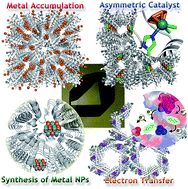Design of protein crystals in the development of solid biomaterials
Abstract
The design of protein crystals has become a growing field in materials science and biotechnology. Protein crystals have immense potential for use as new porous materials that allow the precise arrangement of exogenous compounds by metal coordination and chemical conjugation in the solvent channels of the crystals. Generation of novel protein crystal lattices and regulation of chemical environments by design of protein interfaces represent important efforts in this field. In this review, we focus on recent advances in the preparation of 2D and 3D protein crystals by several approaches including protein engineering, ligand-mediated assembly, interfacial metal coordination, symmetric assembly by engineered proteins, genetic fusion of protein domains, and computational design of protein interfaces. A major advantage of using protein crystals as solid materials is that they can be utilized as porous biomaterials for accumulation of functional molecules, such as metal ions, metal complexes and inorganic nanoparticles. Protein crystals can be used in applications such as separation processes, heterogeneous enzymatic catalysis and drug delivery systems. It is expected that engineering of protein crystals will provide remarkable advances in the field of materials science.


 Please wait while we load your content...
Please wait while we load your content...